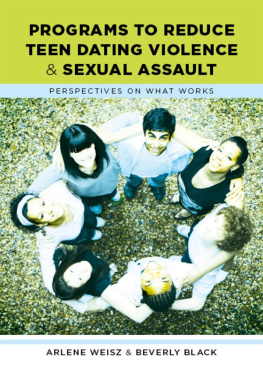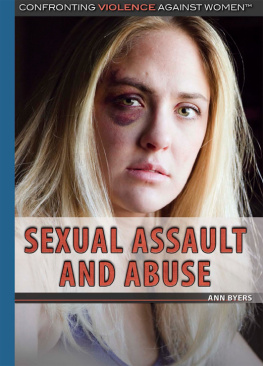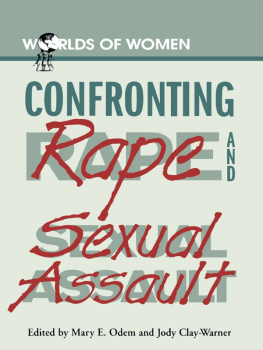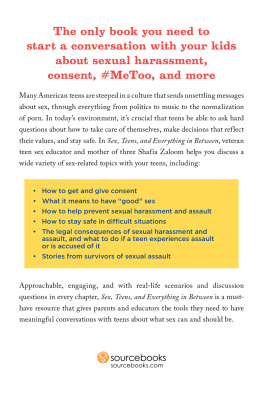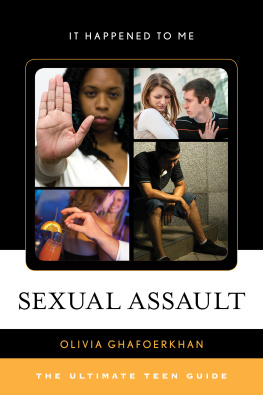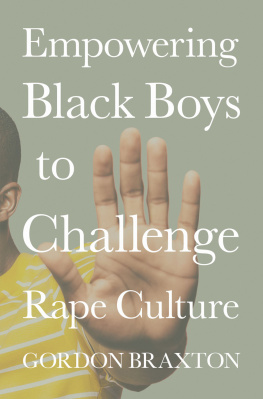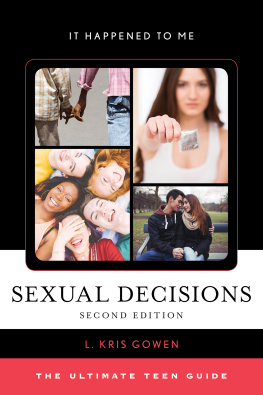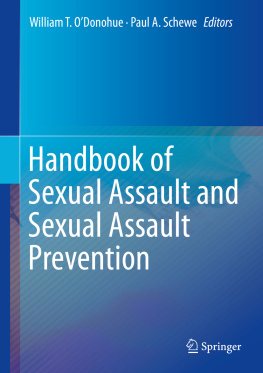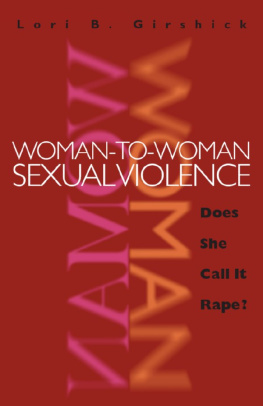Programs to Reduce Teen Dating Violence and Sexual Assault
Programs to Reduce Teen Dating Violence and Sexual Assault
PERSPECTIVES ON WHAT WORKS
Arlene N. Weisz
and
Beverly M. Black
Columbia University Press New York
Columbia University Press
Publishers Since 1893
New York Chichester, West Sussex
cup.columbia.edu
Copyright 2009 Columbia University Press
All rights reserved
E-ISBN 978-0-231-50882-7
Library of Congress Cataloging-in-Publication Data
Weisz, Arlene N.
Programs to reduce teen dating violence and sexual assault :
perspectives on what works / Arlene N. Weisz and Beverly M. Black.
p. cm.
Includes bibliographical references and index.
ISBN 978-0-231-13452-1 (hard cover : alk. paper)
ISBN 978-0-231-13453-8 (pbk. : alk. paper)
ISBN 978-0-231-50882-7 (ebook)
1. Dating violenceUnited StatesPrevention. 2. Youth and violenceUnited States. 3. Teenage girlsAbuse ofUnited States. 4. Victims of dating violenceUnited States. 5. Child sexual abuseUnited StatesPrevention.
I. Black, Beverly M. II. Title.
HQ801.83.W45 2009
362.880830973dc22 2008047972
A Columbia University Press E-book.
CUP would be pleased to hear about your reading experience with this e-book at .
References to Internet Web sites (URLs) were accurate at the time of writing. Neither the author nor Columbia University Press is responsible for URLs that may have expired or changed since the manuscript was prepared.
To survivors of violence and those who work to prevent it.
A.N.W
In memory of my mother and Michael, and to all others who have worked and continue to work to end violence against women and dream of a world without violence.
B.M.B.
Contents
First and foremost we want to acknowledge and thank the prevention educators who participated in interviews for the book. Without their willingness to take valuable time from their busy schedules to share their knowledge and perspectives, this book would not have been possible. We are deeply grateful.
We want to thank the School of Social Work at Wayne State University for its support. Dean Phyllis Vroom initially supported our taking sabbaticals during the same semester despite the extra burden this created for her and the school. This time allowed us to work closely together throughout the semester. Dean Vroom also offered encouragement and repeatedly supported the project with use of the schools resources. The schools editor, Al Acker, provided helpful edits on the entire book. Our colleague Jerry Brandell read drafts of material and offered valuable advice; he also supported and encouraged us throughout the process. Additionally, numerous graduate students and our secretary assisted throughout this project: Ryan Hertz, Cheryl Collins, Rachel West, Rebecca Wiersma, and Marie Villanueva. We thank you for your help and comments. Our colleagues and friends, Peggy Brunhofer and Neva Nahan, listened to our many frustrations and supported our determination to continue on through to the completion of the book.
We want to thank Columbia University Press for believing in the project and especially John Michel, who saw such promise in the project during its early stages of development.
Lastly, we want to thank our families: Arlene thanks her friends and family for their support and enthusiasm about this project and her professional growth. Beverly thanks Robert for his support in all her work and especially with this long and intense project. He never complained about the many hours she devoted to the project and provided technical support for telephone gadgets and computers. Joshua and Nathan, I thank you for always asking how the book was coming along.
This book describes the successful programs that experienced practitioners have implemented to prevent dating violence and sexual assault among adolescents. The authors, experienced researchers and prevention-program coordinators themselves, have observed that prevention practitioners seldom publish their experience or research and often are too busy to attend conferences to share their knowledge. We therefore undertook to write this book so our readers can learn from experienced presenters of teen dating violence and sexual assault prevention programs across the United States. As the book describes in detail, we interviewed experienced practitioners across the country. Our goal was to learn as much as possible about prevention programming. We also conducted an extensive review of published literature relevant to these programs, so that we can present both practice and published wisdom.
Our own work in youth dating violence and sexual assault prevention began more than ten years ago. We coordinated a prevention program for middle school youth in Detroit over a five-year period. We offered this program primarily in a charter school setting, with a brief change of venue to a youth program in a large church. Beverly Black went on to coordinate a prevention program in public middle schools in Detroit for another four years. We both have also worked with adolescents in other settings.
Working with prevention programs taught us a great deal but also raised many questions that were not answered in the literature or at conferences. Although prevention programs across the United States were doing excellent work with adolescents, only a few published their experiences or presented them at meetings. As a result, we developed a plan to interview prevention practitioners across the country. It was a privilege to talk with these hard-working, thoughtful people, and we are excited to share their thoughts and experiences with our readers.
In this chapter we discuss why practice wisdom, along with research studies, can make an important contribution to continuing and improving prevention programs. We also address the strengths and limitations of both empirical evaluations of prevention programs and the literature about practitioners views on research.
Prevalence of Dating Violence and Sexual Assault among Adolescents
Before our first prevention program we talked with staff members of public schools in our city and learned that the teachers and counselors who worked closely with youth every day were well aware that many adolescents experience dating violence and sexual assault. Many people who work with adolescents often do not need research to tell them that this is a common and serious problem among their clients or students. At the same time research findings support practitioners concerns that dating violence and sexual assault are serious societal problems.
Studies in the U.S. have found that between 11% and 59% of high school students have experienced dating violence (Bergman 1992; Center for Disease Control [CDC] 2003; Foshee et al. 1996; Malik, Sorenson, and Aneshensel 1997; Molidor and Tolman 1998; Silverman et al. 2001) and that dating violence impacts youths physical and psychological well-being (Callahan, Tolman, and Saunders 2003; Silverman et al. 2001). Data also suggest that adolescent victims of abusive relationships may carry these abusive patterns into future relationships (Smith, White, and Holland 2003). Although definitions of sexual assault in published studies vary, these studies report that between 9% and 18% of female adolescents have been sexually victimized by a dating partner (Foshee et al. 1996; Molidor and Tolman 1998; OKeefe and Treister 1998). The CDCs Youth Risk Behavior Screening Survey (YRBSS) (CDC 2008), which assesses risk behaviors among adolescents across the United States, revealed that over 7.8% of high school students reported that they had been physically forced to have sex when they did not want to.


